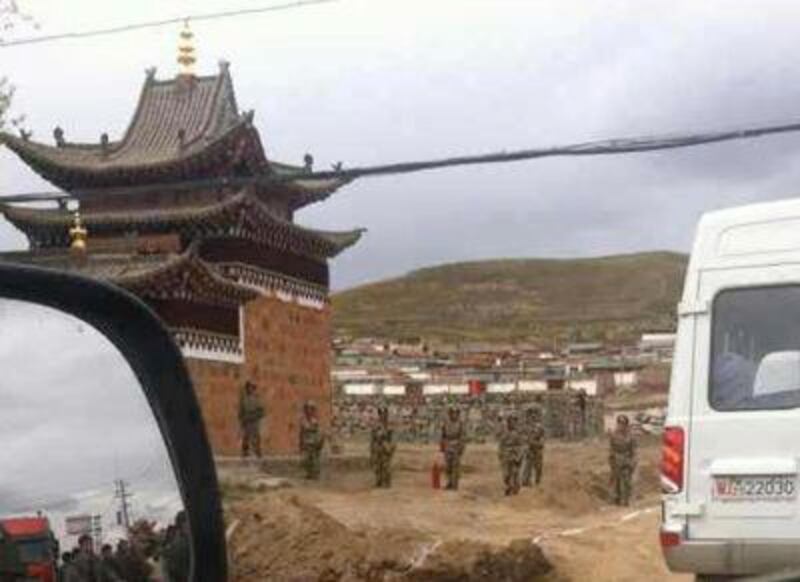A Tibetan man set himself on fire in protest against Chinese rule and died Saturday in a Tibetan populated area in Gansu province, in the same county where another man self-immolated last week, according to local residents.
Tamdin Dorjee, 54, the grandfather of a revered Tibetan Buddhist figure, self-immolated on the grounds of the Tsoe monastery in Tsoe (in Chinese, Hezuo) county, the administrative center of the Kanlho (Gannan) prefecture in southern Gansu.
“He did it a little after 1:00 p.m. local time on October 13, and died,” a Tsoe resident told RFA’s Tibetan service.
Security forces moved into the area as monks took his body to his home village, another resident said.
“The monks of Tsoe monastery and Tibetans who reached the site of the self-immolation took the body of Tamdin Dorjee to his home village.”
“At the same time, large numbers of police both in uniform and in plainclothes flooded the area,” the source said.
“The Chinese police also arrived at the home village of Tamdin Dorjee. They had already put restrictions on phones and other lines of communication.”
Photos of the scene obtained by RFA showed security forces on the grounds of the monastery and dozens of monks and bystanders gathering around Tamdin Dorjee’s burned body to say prayers.
Tamdin Dorjee, who left behind a wife and three grown children, was the grandfather of the 7th Gungthang Rinpoche, one of the most important religious leaders in the region.

Tsoe county
His burning protest is the second self-immolation death in Tsoe county in a week, following Sangay Gyatso who set himself on fire on Oct. 6 at the Dolkar monastery 10 kilometers (6 miles) outside the Tsoe town center.
After Sangay Gyatso’s self-immolation, authorities severed communications and interrogated monks at the Dolkar monastery, sources said this week.
Tamdin Dorjee brings to 55 the total number of self-immolations challenging Chinese rule since the wave of fiery protests began in February 2009.
Most of the burning protests have occurred in Tibetan-populated areas of the Chinese provinces of Sichuan, Qinghai, and Gansu.
The location of his protest on the monastery grounds was the same site where a 26-year-old mother of two, Dolkar Tso, died after setting herself on fire in August.
“Tamdin Dorjee self immolated at the same site of the last incident of self-immolation near a stupa in the compound of Tsoe monastery,” the same source said.
The Tsoe monastery is an important one for Tibetan Buddhists and monks from the monastery were among participants in large-scale protests in the area against Chinese rule in 2008.
Appeal
The 55th self-immolation came despite an appeal by more than 400 Tibetan exiles from 26 countries to end the burning protests.
The exiles had met in the Indian hill-town of Dharamsala, where Tibetan spiritual leader the Dalai Lama lives in exile, and expressed “grave concern” over the burnings and urged Tibetans living under Chinese rule not to take “drastic actions.”
“Tibet is a thinly populated country, and in the present situation losing even one life is a great loss for the Tibetan people,” said one of 31 recommendations and resolutions adopted by the delegates to the four-day gathering, the largest meeting of its kind in four years.
“Please preserve your lives in the future,” it said.
Similar expressions of concern from exile figures and from the Dalai Lama himself over the burnings have gone largely unheeded in the past.
Reported by Kunsang Tenzin, Kalden Lodoe, Lobsang Sherab, and Guru Choekyi for RFA's Tibetan service. Translated by Karma Dorjee. Written in English by Rachel Vandenbrink.
